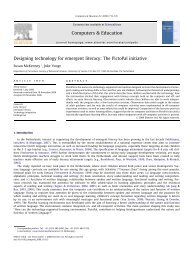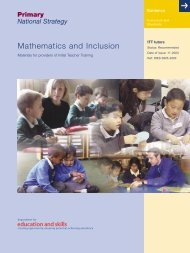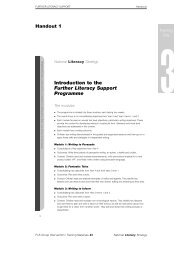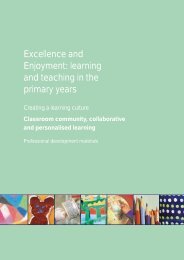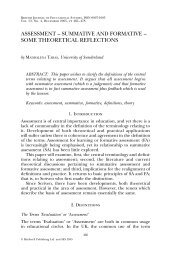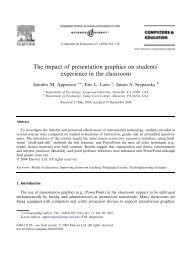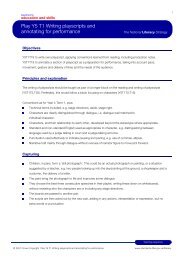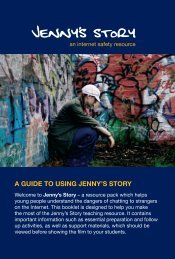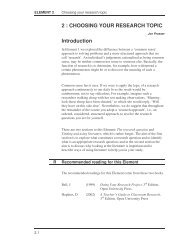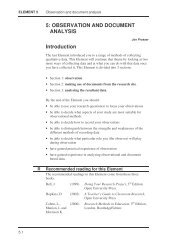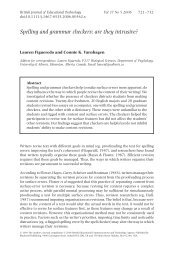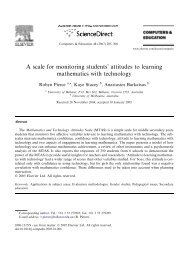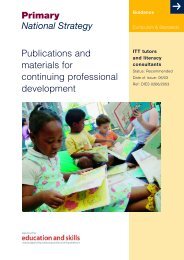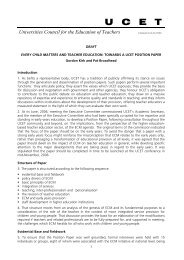Narrative Y4T1 Planning, paragraphs and character sketches - PGCE
Narrative Y4T1 Planning, paragraphs and character sketches - PGCE
Narrative Y4T1 Planning, paragraphs and character sketches - PGCE
Create successful ePaper yourself
Turn your PDF publications into a flip-book with our unique Google optimized e-Paper software.
department foreducation <strong>and</strong> skills<strong>Narrative</strong> Y4 T1 <strong>Planning</strong>, <strong>paragraphs</strong> &<strong>character</strong> <strong>sketches</strong>The National Literacy Strategy1Objectives<strong>Y4T1</strong>T9 to use different ways of planning stories, e.g. brainstorming, notes, diagrams;<strong>Y4T1</strong>T10 to plan a story identifying the stages of its telling;<strong>Y4T1</strong>T11 to write <strong>character</strong> <strong>sketches</strong>, focusing on small details to evoke sympathy or dislike in historical stories,e.g. How would I have responded? What would I do next?;<strong>Y4T1</strong>T15 to use <strong>paragraphs</strong> in story writing to organise <strong>and</strong> sequence the narrative.Principles <strong>and</strong> explanationThe activities are planned for a week’s work (at least) when The Wreck of the Zanzibar by Michael Morpurgo isbeing read to the class. As it draws to a close, the narrative is used to develop a further narrative of the heroine’sbrother Billy’s voyage <strong>and</strong> adventures aboard the Zanzibar. There are several related text-level reading objectives:<strong>Y4T1</strong>T1 to investigate how settings <strong>and</strong> <strong>character</strong>s are built up from small details, <strong>and</strong> how the reader respondsto them;<strong>Y4T1</strong>T2 to identify the main <strong>character</strong>istics of the key <strong>character</strong>s, drawing on text to justify views, <strong>and</strong> using theinformation to predict actions;<strong>Y4T1</strong>T3 to explore chronology in narrative using written or other media texts, by mapping how much time passesin the course of the story, e.g. noticing where there are jumps in time, or where some events are skimmed overquickly <strong>and</strong> others told in detail;<strong>Y4T1</strong>T4 to explore narrative order: identify <strong>and</strong> map out the main stages of the story:introductions build ups climaxes or conflicts resolutions.Diaries are powerful vehicles for reflecting the emotional stance of the writer. During this work, the class build anarrative for the unknown experience of Billy Perryman while on board ship. His departure is a turning point in thetext, yet we read little or nothing about his life, hearing only about the consequences for Laura <strong>and</strong> her family onthe isl<strong>and</strong> of Bryher. In this sequence of work his <strong>character</strong> is developed through flashbacks <strong>and</strong> interiormonologues, <strong>and</strong> his relationship with Joseph Hannibal is explored. He is a contrasting <strong>character</strong> <strong>and</strong> again oneabout whom little is known.The week’s work culminates in the production of A Class Diary of Billy Perryman which documents moments inthe sequential narrative of his life at sea. His adventures are planned retrospectively at the close of the book <strong>and</strong>mirror, in form, the diary entries of the text itself, which is his sister’s diary. Prior to the week, read The Wreck ofthe Zanzibar by Michael Morpurgo, at least as far as page 110, when Billy, Laura’s brother, returns safely homeaboard the wrecked Zanzibar.© 2001 Crown Copyright <strong>Narrative</strong> Y4 T1 <strong>Planning</strong>, <strong>paragraphs</strong> & <strong>character</strong> <strong>sketches</strong> www.st<strong>and</strong>ards.dfes.gov.uk/literacy
2Day OneCapturing ideas: reading with a writer’s eyeReread pages 108 to 110 <strong>and</strong> think about the kinds of places Billy might have visited, about his ‘friend’ JosephHannibal (who had arranged for Billy to join a ship as a cabin boy), as well as discussing how Billy felt about hisadventures.Ask the class to work in groups, creating freeze-frame flashbacks of one of Billy’s very early encounters when, afew days after he left Bryher, he wondered whether he’d made the right decision. Once these are nearly readyask each group to title their tableaux, writing on long strips of paper.Observe these as a class. You could now reread pages 31 to 34, when Billy determines to leave Bryher, to enrichtheir underst<strong>and</strong>ing of his state of mind at the time. Then, select one of the incidents shown when Billy wasscared/fed up/lonely, etc. <strong>and</strong> undertake interior monologues. In this drama convention, each child (<strong>and</strong> you) is inrole as Billy, speaking out loud Billy’s thoughts <strong>and</strong> worries at the moment of tension. These inner thoughts aresimultaneously voiced in class <strong>and</strong> will help the children empathise with the <strong>character</strong>.Shared writingKeep the atmosphere reflective <strong>and</strong> together scribe Billy’s diary entry that evening on board ship. Aim to create apiece of writing that:describes the events of the day <strong>and</strong> Billy’s role in them;indicates how Billy feels about the situation;implies/states what he is going to do about his situation;reveals something of Billy’s <strong>character</strong>, e.g. behaviour, emotions, language.Review this piece together in relation to the aims above that you set yourself.Supported compositionAsk the class to write a reflective recount of that day, or another early entry, in role as Billy, which includes thestr<strong>and</strong>s above <strong>and</strong> reveals his <strong>character</strong> traits <strong>and</strong> vulnerability. During the writing (after 10 minutes perhaps),intervene <strong>and</strong> ask children to read aloud evidence of one of the str<strong>and</strong>s to ensure that all are encompassed <strong>and</strong> along description of the event is avoided.In the plenary read examples <strong>and</strong> list on the easel what is now known about Billy - do the children feelsympathetic towards his plight or has he received his just deserts for ab<strong>and</strong>oning his family in search of a newlife? Reflect upon the values expressed in his behaviour.Day TwoCapturing ideas: dramaReread page 27, in which Joseph Hannibal, the old sailor, is described. Suggest that Hannibal is hot seated soyou can build up a richer picture of this <strong>character</strong>. Ask for a couple of volunteers to join you on the hot seat.Hypothesise that some investigators/journalists who were exploring Billy’s whereabouts went to interviewHannibal on his return to Engl<strong>and</strong>.© 2001 Crown Copyright <strong>Narrative</strong> Y4 T1 <strong>Planning</strong>, <strong>paragraphs</strong> & <strong>character</strong> <strong>sketches</strong> www.st<strong>and</strong>ards.dfes.gov.uk/literacy
Provide time for questions to be generated (in pairs) <strong>and</strong> recorded on whiteboards, while you discuss Hannibal’s<strong>character</strong> with those adopting his role. Try to weave in Day One’s ideas about Billy <strong>and</strong> Hannibal. Join the childrenon the hot seat <strong>and</strong> try to highlight three str<strong>and</strong>s in Hannibal’s relationship with Billy:meeting <strong>and</strong> persuading;life on board ship - comradeship;difficulties <strong>and</strong> the eventual split.3Shared writingAfter the hot seating activity, ask the class to state what they now know about Hannibal. Record these on theboard around a silhouetted head shape - separating factual information from opinion <strong>and</strong> recording the viewsexpressed <strong>and</strong> the evidence offered. For example “he’s mean <strong>and</strong> selfish - he said he’d forgotten to return Billy’smoney but I don’t believe he ever meant to return it, he had plenty of opportunities”. This scribing activity createsa bridge between the drama <strong>and</strong> later writing, relies upon inferential underst<strong>and</strong>ing <strong>and</strong> deduction <strong>and</strong> providesuseful raw material for the class to use in their <strong>character</strong> descriptions.DemonstrationShow the class how to use this <strong>character</strong> knowledge in a brief paragraph about Hannibal, documenting his earlyrelationship with Billy on l<strong>and</strong>. Highlight ways of integrating the phrases <strong>and</strong> insights recorded about him into thewriting <strong>and</strong> explain what these add to the sense of his <strong>character</strong>.Supported compositionChallenge the class to write two <strong>paragraphs</strong>, one about Billy’s early relationship with this sailor <strong>and</strong> one about hisdeveloping comradeship with the man. These need to convey Joseph Hannibal’s <strong>character</strong>: his behaviour,speech, appearance <strong>and</strong> emotions. Intervene to share examples <strong>and</strong> to ask the class to underline the words,phrases <strong>and</strong> ideas they’ve used from the hot seat. Praise their ability to make use of these ideas in their writing.In the plenary, use response partners, <strong>and</strong> then share some examples with the whole class.Day ThreeCapturing ideas: class discussion <strong>and</strong> dramaRemind the class how the relationship deteriorated between Billy <strong>and</strong> Hannibal <strong>and</strong> how following a final incidentof some kind, Billy left the General Lee <strong>and</strong> got a job on board the Zanzibar. Discuss suggestions about whathappened <strong>and</strong> list these. Suggest the children in pairs/groups improvise the incident which prompted Billy’sdeparture. They could do this sitting down or in the available space. Listen to/observe snippets of these as aclass.Shared writingChoosing one idea or dominant theme, scribe their suggestions as another entry in Billy’s diary about thissignificant incident <strong>and</strong> his decision to leave the General Lee <strong>and</strong> seek work elsewhere. Review the entry as aclass - what does it state or imply about Billy’s emotions at this time? how does the writing convey Billy’smotivations <strong>and</strong> feelings at this time?Supported compositionAsk the children to make their own diary entry, in role as Billy, about the incident. For differentiation purposes,some may be challenged to weave in other memories of difficulties between the pair, as flashbacks in thenarrative. Highlight <strong>and</strong> discuss how their writing conveys knowledge about Billy’s emotional state. What mighthis mother have thought had she read the entry?© 2001 Crown Copyright <strong>Narrative</strong> Y4 T1 <strong>Planning</strong>, <strong>paragraphs</strong> & <strong>character</strong> <strong>sketches</strong> www.st<strong>and</strong>ards.dfes.gov.uk/literacy
4Day FourShared writingShow the class a large emotions graph you’ve begun on the board, which illustrates some of the significantmoments in Billy’s adventures. Explain how this maps out the main stages in Billy's adventures <strong>and</strong> highlights hisperspective. See the diagram below.Show the class how this can reflect Billy’s feelings at these moments in his narrative <strong>and</strong> add a word or phrase todescribe his emotional state each time. Map in the moments which have been explored so far in the week’swork. Explain how each of these incidents could represent a paragraph in Billy’s journey. Ask the class tosuggest two or three more incidents, <strong>and</strong> their related emotions, which can be added <strong>and</strong> may also reflect histime aboard the Zanzibar.DemonstrationSelect one ‘new’ incident <strong>and</strong> compose a paragraph about it as a diary entry, modelling the process of describingthe action, talking through Billy’s emotional stance <strong>and</strong> perhaps his thoughts about this part of his journey.Review whether your writing has effectively conveyed a sense of Billy’s <strong>character</strong>, his role in events, his behaviour,emotions <strong>and</strong> language.Supported compositionAsk the children to choose one of Billy’s experiences mapped onto the emotions graph <strong>and</strong> write a paragraphwhich both reveals more about Billy <strong>and</strong> describes the incident. Review these <strong>and</strong> hear a range of exampleswhich span his emotional highs <strong>and</strong> lows.© 2001 Crown Copyright <strong>Narrative</strong> Y4 T1 <strong>Planning</strong>, <strong>paragraphs</strong> & <strong>character</strong> <strong>sketches</strong> www.st<strong>and</strong>ards.dfes.gov.uk/literacy
5Day FiveCapturing ideas: drama <strong>and</strong> storytellingRevisit the emotions graph, which tells Billy’s tale, <strong>and</strong> allocate particular moments to groups. Agree a rough timeframe so each group can date their entry <strong>and</strong> add the dates to the emotions graph. Ask each group to show theirincident as a freeze frame <strong>and</strong> watch each tableau in sequential order. As the narrator, tell the tale from yourperspective (Billy’s) as if you were rereading your diary entries after your safe return home <strong>and</strong> telling Laura aboutyour trip. Highlight the passage of time <strong>and</strong> explore the consequences of previous incidents on your behaviour.DemonstrationUsing an enlarged copy or OHT of one child’s writing from Day Four, together as a class highlight the strengths ofthis piece <strong>and</strong> areas for the child to work on in relation to the objectives set. Involve the child concerned <strong>and</strong> theclass’s views. Model how it might be improved.Supported compositionAsk the class to select one of their previously written <strong>paragraphs</strong> from earlier in the week <strong>and</strong>, joining with aresponse partner, review it <strong>and</strong> reshape it to make it more effectively convey Billy’s <strong>character</strong>, his views of others<strong>and</strong> his experience. Explain that these entries are going to be published in a class diary of Billy Perryman.Intervene during this work to share specific examples of changes being made. Challenge each child to produceone edited paragraph. These can be proof read, word processed, illustrated, dated, ordered <strong>and</strong> made into adiary which documents Billy’s journey from Bryher across the oceans <strong>and</strong> back home again. This can be placedin the school/class library.© 2001 Crown Copyright <strong>Narrative</strong> Y4 T1 <strong>Planning</strong>, <strong>paragraphs</strong> & <strong>character</strong> <strong>sketches</strong> www.st<strong>and</strong>ards.dfes.gov.uk/literacy



